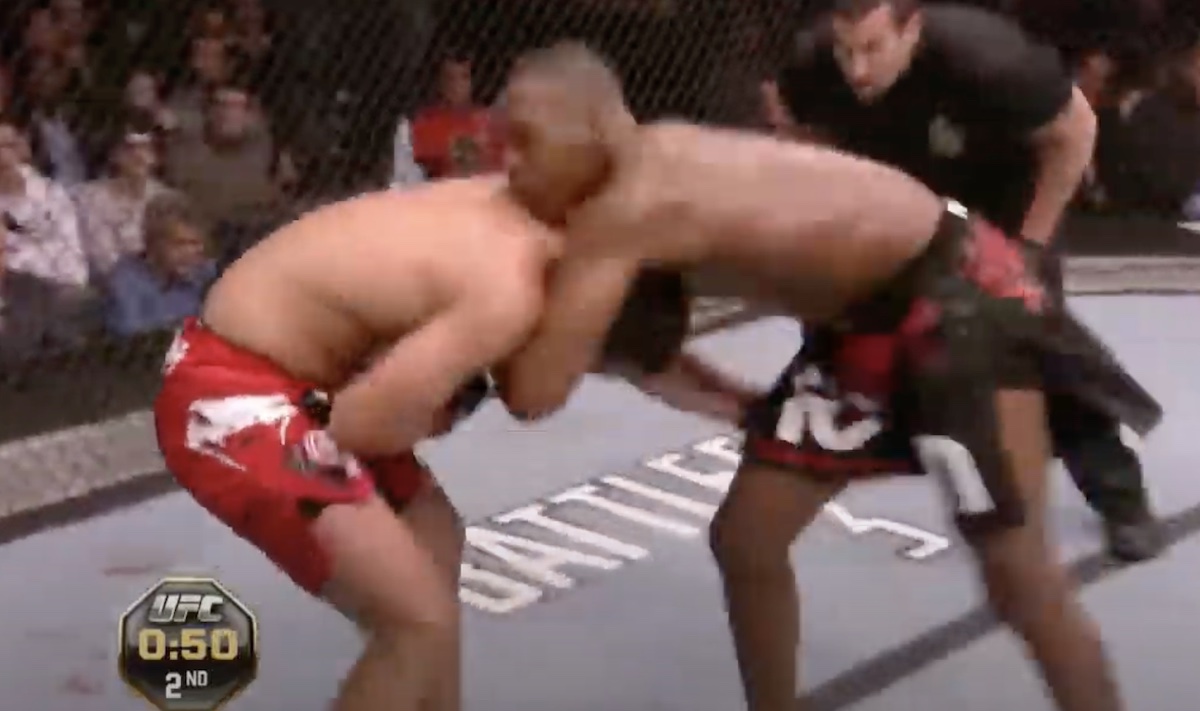Standing Guillotine Choke

We’ve already gone over just about everything you need to know about the guillotine choke in our previous write up. But we just want to come back to the submission and specifically talk about the standing guillotine choke.
The standing guillotine choke is a very effective variation of the submission. Not just for sport Jiu Jitsu, but also for self-defense purposes.
Here is everything you need to know about the standing guillotine choke. We’ll go over important details to lock in a standing guillotine choke and different ways to defend against the submission.

Contents
Why is it good to know a standing guillotine choke?
A standing guillotine choke is a phenomenal submission to learn. There are various ways to lock it in and numerous benefits of knowing how to execute them. Below are some of the benefits of knowing how to lock in a standing guillotine choke.
Easier to learn the grips
The standing guillotine choke is actually the easiest of the guillotine choke to learn. All you have to learn is to break your opponent’s posture and lock in your grips.
An alternative to take takedowns
If you aren’t the best at takedowns, you can still be effective on the feet by learning a standing guillotine. If you develop the skill of breaking your opponent’s posture, then the path to a standing guillotine opens up.
Safer in a self defense situation
If you find yourself in a self defense situation, then grabbing a guillotine and pulling guard isn’t the best option. Especially if you’re fighting on a hard service like concrete.
It would be better to snatch up your opponent’s neck and lock in the choke or just put them on the ground.
You also must know how to defend a standing guillotine choke for self defense purposes. One of the main things an attacker likely will try to do is grab your head and choke you.
Basic standing guillotine choke
A basic standing guillotine choke usually starts from standing in a collar tie position. You and your opponent both have an overhook and an underhook.
On your overhook side, you’re going to take your hand and grab a clinch on your opponent’s head. Aim to cup the back of their head, where it curves.
Once you get a good clinch grip, you’re going to pass the opponent’s head under your armpit. As it goes under your armpit, immediately start locking in your grip.
There’s different grips you can use, but just go ahead and use a basic hand on wrist grip. Be sure to grab right where your hand and wrist connect to allow you to angle better on the choke.
After you set your grip, you’re going to need to close your elbow to close off any free space. Your opponent will have an easier time escaping if you don’t close your elbow in.
Now a common reaction by your opponent is to back out of the choke. To keep them trying to back out, put your chin on their back to keep them close.
You’re now ready to finish your standing guillotine choke. Take a step in, pull your hand up, and put on the pressure.
Jon Jones style standing guillotine
This is a variation of the standing guillotine choke that Jon Jones has done many times and also Max Holloway. It starts off the same as a basic guillotine, where you’re locked up with your opponent in a collar tie.
You’re pushing and pulling with your opponent and then you clinch their head to snap them down. From the snap down, you can either push their head to the same side armpit or opposite side armpit.
Where this differs from the normal standing guillotine is the grip. With this variation, you don’t actually grip your hands together.
What you actually do is place your free hand under your choke hand and push it up. At the same time you’re pushing up, your head is hunched over their body to keep their head from popping out.
This is a great submission to use for MMA and especially a self defense situation. In a self defense situation, you can use the head control to push your attacker against a wall or bar.
Way safer than pulling guard and ending up on the hard ground, where you’re more likely to get hurt.
Standing guillotine choke defenses
You not only need to know how to perform standing guillotine chokes, but know how to defend them. These defenses are vital to know for both sport BJJ and self defense. Here are some methods to use to defend against standing guillotine chokes.
Basic standing guillotine defense
Here is the basic way to defend against a standing guillotine choke. When your opponent grabs your head and goes for the choke, you have to react immediately.
When they grab the choke, you have to grab their wrist, look up, and wrap your arm over their back. Putting your arms in these positions will help take the pressure off the choke when your opponent cranks up.
When your opponent cranks up, you’re going to move your body to the opposite side of their choke. Then you’re going to position your legs around their leg with your knee behind their knee.
Now, you’re going to take your opponent down, tap your knee behind their knee as you push them back. You fall into side control and they can’t finish the guillotine.
Standing guillotine counters to takedowns
There are quite a few different takedowns you can do to counter the standing guillotine. Here are two different ones you can use.
Both of these defenses start with the same principle of popping your head up when your opponent tries the guillotine. As soon as they go for it, pop your head up and step in.
From there, your first option is to step, grab a bodylock, turn, lift, and takedown. Then your second option is to pop your head up, step to the opposite side of the guillotine, and double leg.
You can do both of these techniques in a drill sequence, where you pop your head up and go for them.
Tips for doing a standing guillotine choke
A standing guillotine choke looks easy enough, but there’s important details you need to remember to do it effectively. Here are some tips for doing a standing guillotine choke.
- Break Their Posture: To set up the choke, you’re going to need to break down your opponent’s posture. You will not finish the submission if you do not perform this step.
- Get Your Grips: After breaking your opponent’s posture you must quickly set up your grips. Do not try to squeeze the submission until your grips are set and get your hand under their chin.
- Turn Your Elbow Down: Once your grips are set, lock in the pressure by dropping the elbow of your choke hand down. At the same time, you pull your choke hand up to make the choke feel like a noose around their neck.
- Don’t Arch Back: A tendency beginners will do with the standing guillotine is to arch their back as soon as they grip their hands. Try not to do this as it doesn’t give optimal pressure on your opponent’s neck.
- No Space: Of course like many submissions, you cannot have any free space when trying a standing guillotine choke. This will give your opponent an easier chance of escaping your submission.
- Step In: Before you try to finish the choke, take a step into your opponent. This will close space and make your standing guillotine choke tighter.
Tips proper standing guillotine defense
Defending a standing guillotine choke is just as important as knowing how to lock one in. Here are some tips for how to defend a standing guillotine choke.
- Don’t Get Your Posture Broken: The first thing you can do to avoid a standing guillotine choke is not allow your posture to be broken. If your posture isn’t broken, your opponent can’t do a standing guillotine.
- Chin Ups: Remember to keep your chin up if you get put in a standing guillotine. Your opponent needs to bend your neck and put your chin down to finish the choke.
- Grab The Wrist: One of the first things you need to do if you’re in a standing guillotine is grab your opponent’s wrist. Pull their wrist down to make space and keep them from pulling it up.
- Arm Over The Back: After you grab your opponent’s wrist, wrap your free arm over your opponent’s back. This will take pressure off the check and help you take your opponent down.
- Make An Angle: Once you’re in a standing guillotine choke, you must angle your body away from your opponent’s choke side. This will take pressure off the choke and give you a better chance at escaping it.






